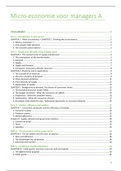Summary
Samenvatting Micro-economie A - Handelswetenschappen (Campus Brussel)
- Course
- Institution
Dit is een samenvatting van wat je moet kennen voor het examen Micro-economie A (zie inhoudstabel). Alle slides en notities zijn hier in verwerkt. Deze samenvatting is handig om een structuur op te bouwen en een mooi inzicht te krijgen van de leerstof. Vergeet geen sterretjes te geven om te zeggen...
[Show more]



